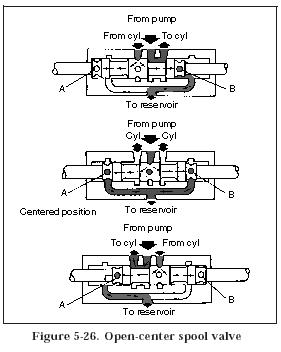The four-way, sliding-spool, directional-control valve is simple in operation principle and is probably the most durable and trouble free of all four-way, directional-control valves in current use. Figure 5-24 shows a typical four-way, sliding spool, directional-control valve. The valve body contains four fluid ports: pressure, return/exhaust, and two working ports (referred to as cylinder ports). A hollow steel sleeve fits into the main bore of the body. Around the outside diameter of the sleeve are O-ring gaskets. These O-rings form a seal between the sleeve and the body.
In Figure 5-24, diagram A, the valve is at the far right in its cylinder. Liquid from the pump flows to the right end of the cylinder port, while liquid from the left end returns to the reservoir. In diagram C, the situation is reverse. The piston is to the far left in its cylinder. Liquid from the pump flows to the left end of the cylinder port, while liquid from the right end returns to the reservoir. In diagram B, the piston is in an intermediate position. Flow through the valve from the pump is shut off, and both ends of the cylinder can drain to the reservoir unless other valves are set to control the flow.
In a closed-center spool valve, a piston is solid, and all passages through a valve are blocked when a piston is centered in its cylinder (see Figure 5-24, diagram B). A closed-center valve is used when a single pump or an accumulator performs more than one operation and where there must be no pressure loss in shifting a stroke direction at a work point.
In an open-center spool valve, the spools on a piston are slotted or channeled so that all passages are open to each other when a piston is centered (see Figure 5-25). In some open-center valves, passages to a cylinder port are blocked when a valve is centered and liquid from a pump is carried through a piston and out the other side of a valve to a reservoir (see Figure 5-26). Liquid must be carried to both ends of a piston of a directional valve to keep it balanced. Instead of discharging into a reservoir when a valve is centered, liquid may be directed to other valves so that a set of operations is performed in sequence.
Open-center valves are used when a work cylinder does not have to be held in position by pressure and where power is used to perform a single operation. These valves also avoid shock to a system when a valve spool is moved from one position to another, since in the intermediate position, pressure is temporarily relieved by liquid passing from a pump directly to the reservoir.


